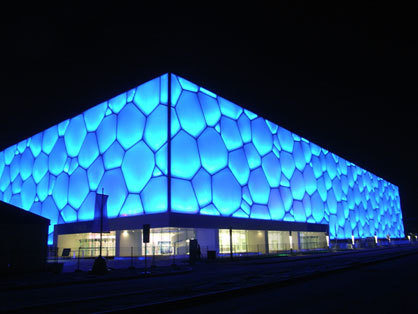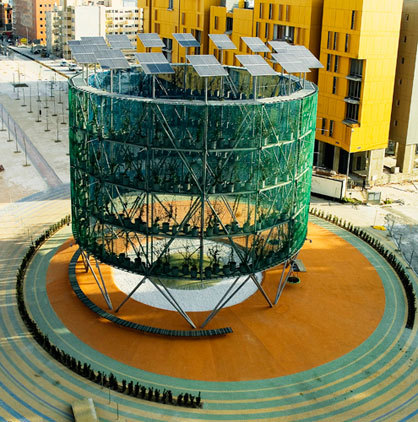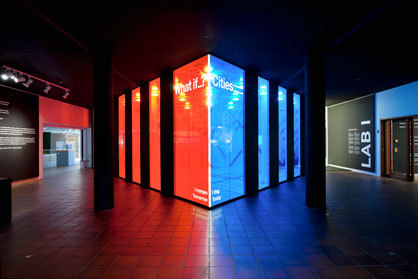Green Architecture for the Future
Scritto da NoéMie Schwaller
Zürich, Svizzera
23.07.09
29 May – 4 October 2009 at the Louisiana Museum of Modern Art, Copenhagen
A sustainable lifestyle involves consciousness-raising about the relationship between consumption today and the conditions for future generations. Sustainable development requires a balance between mankind’s consumption, the environment and the available resources.
PTW Architects: The Watercube, National Aquatics Centre, Beijing, 2006. Photo: PTW Architects
Sustainable thinking must be a natural reflex for the architect of the future. The architect works on the basis of a new order where the building as a whole meets the requirements and challenges of a sustainable future. Sustainable architecture incorporates environmentally sound measures and new ‘intelligent’ materials in an aesthetic and social programme.
These are the crucial themes elucidated in the big architectural exhibition at the Louisiana in the summer of 2009.
ECOSISTEMA URBANO, Madrid: Eco Boulevard i Vallecas, Madrid, 2008. Photo: Ecosistema Urbano
Mario Cucinella Architects, Bologna: SIEEB; Beijing, 2006. Photo: Daniele Domenicali
Architecture is facing what is perhaps the greatest new technological and aesthetic departure since modernism. But how is this manifested in down-to-earth as well as more sophisticated projects which together fulfil society’s human and technological visions? And has there been an architectural and artistic response?
T. R. Hamzan & Yeang Sdn. Bhd. (Llewelyn Davies Yeang, U.K.)
William McDonough + Partners: Tower of Tomorrow, Projekt, 2006. Rendering
At present, epoch-making changes are taking place in architecture. New visions, the use of new, different construction materials, alternative structures and revolutionary proposals for the solutions to challenges when it comes to the development of sustainable cities, landscapes and environments, are on the agenda. Concepts like ‘paradigm shift’ have been used – that is, the idea that a new world-picture is emerging, starting in the 21st century. In this world-picture sustainability is a key concept. Louisiana’s exhibition Green Architecture for the Future takes the pulse of the process of transformation that is in full swing, and the exhibition will show some of the complex initiatives and future scenarios that are already being drawn up on the global scale.
Installationsphoto: Laboratorium 3: Philippe Rahm. Photo: Brøndum & Co
Sustainable development is traditionally divided up into three different ‘pillars’: economic, environmental and social sustainability. With these three parameters in mind, the task is to conceive of solutions for a world that meets mankind’s needs for technology, comfort and growth right now, without at the same time depriving future generations of the fulfillment of their similar needs.
United Bottle Project by United_Bottle Group UBG (Dirk Hebel, Tobias Klauser, Hanspeter Logo, Jörg Stollmann). Photo: Hans Ole Madsen

United Bottle Project by United_Bottle Group UBG (Dirk Hebel, Tobias Klauser, Hanspeter Logo, Jörg Stollmann). Photo: Hans Ole Madsen
×The headings for the exhibition involve both the cross-disciplinary aspect and the theory and use of other sciences in the architectural field. Where are these new crossover situations taking architecture? And what new paths, forms and techniques are pushing forward the frontiers of architecture? It is the ambition of the exhibition to perform a kind of thematic and chronological acupuncture in the flow that is constantly shifting these frontiers. It inserts its pipette into some of the laboratories of the architectural future that are formulating new proposals today for architecture in a sustainable world.
Installationsphoto: Louisiana pavillon, 2009,3XN, 3XG. Photo: Brøndum & Co
The thematic exhibition is divided into three sections, which are also reflected in Louisiana’s Sculpture Park with installations that physically and tangibly underscore the individual themes. In addition each theme is clarified by four experimental laboratories of the future, which point up the concept of sustainability in discursive and thought-provoking ways.
Hilsen til solen / Greeting to the sun: Nikola Basic, Zadar. Photo: Hans Ole Madsen
A number of architects have been invited to exemplify the themes of the exhibition. The exhibition’s four laboratories have been developed by Ecosistema Urbano (social sustainability), Foster+Partners (the new Co2-waste-free city), Philippe Rahm (physiological and meteorological architecture) and R&Sie(N) (the lifetime of the building and the perishability of materials).
Installationsphoto: Store Sal: By-afsnit. Photo: Brøndum & Co
The exhibition series Frontiers of Architecture I-IV
Louisiana’s exhibition series Frontiers of Architecture I-IV, to be shown in the years up to 2011, sheds light on new, alternative architectural movements today, the paths that point towards what we see as the frontiers of architecture. The first exhibition in the series was Cecil Balmond - Unfolding New Dimensions (2007), which elucidated the relationship between science and architectural design with the engineer Cecil Balmond as an example of the various reflections and explorations that underlie the architecture of today – and not least of the future. The exhibition Green Architecture for the Future is the second in the series.
Installationsphoto: Laboratorium 1: Ecosistema Urbano. Photo: Brøndum & Co




















